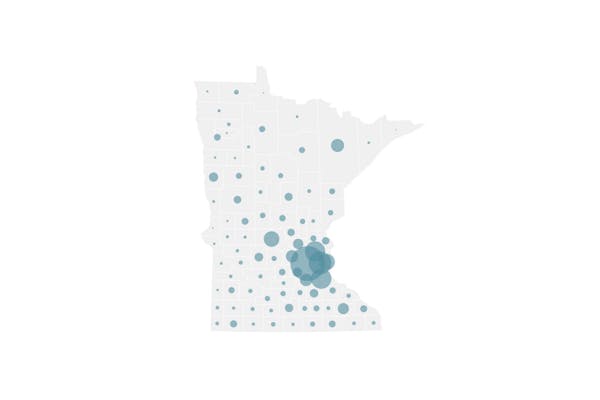Hospitalizations for COVID-19 have declined over the past week in Minnesota from 332 last Monday to 278 on Monday, reflecting continued progress in detecting and managing the infectious disease among the elderly and other high-risk individuals.
The Minnesota Department of Health on Monday also reported 10 deaths from COVID-19, which is caused by a novel coronavirus, bringing the total in the pandemic to 1,435.
The total hospitalizations on Monday included 140 people needing intensive care for COVID-19, which causes mild or no symptoms in the majority of cases but can cause severe respiratory problems and other complications in some patients. That intensive care number is at its lowest since May 2.
The state also reported 315 newly confirmed COVID-19 cases, bringing the state's case count to 35,861. Case counts have always been lower on Mondays during the pandemic, due to less testing and lab activity on weekends.
State health officials remain concerned that daily case counts have been increasing slightly over the past two weeks, particularly as southern states have shown recent surges in both cases and hospitalizations.
Earlier this month, more than half of U.S. states rated on the COVID Exit Strategy website as at least "making progress" in managing the pandemic. On Monday, 36 states — including Minnesota and Wisconsin — are listed as "trending poorly" due to rising case counts.
Minnesota permitted the limited reopening of indoor bars and restaurants, as well as fitness clubs and entertainment venues, on June 10. Health officials said it would take 21 days to assess whether that change resulted in more face-to-face contact and disease transmission — due to the delays between people being infected, experiencing symptoms and then seeking medical attention. Any such effect should be known this week, though.
Case counts in Minnesota have been rising fastest among people younger than 29, who now represent 31% of all known COVID-19 cases. Only two deaths have occurred in this age group, but health officials worry that mobile young adults could spread the virus to people at higher risks — including people 70 and older who have sustained 11% of all known cases but 81% of the state's COVID-19 deaths.
People also are at greater risk of COVID-19 if they have underlying health conditions, including obesity, diabetes, asthma, and diseases of the lungs, heart, kidneys and immune system.
The majority of COVID-19 deaths in the state, 1,129, involved residents of long-term care or assisted-living facilities. That includes six deaths reported Monday. Two deaths reported Monday involved prison or jail inmates.
Health officials hope that expanded availability of diagnostic testing for COVID-19 will help by detecting infections quickly so that people can isolate themselves and not spread the virus to others. The state reported the lab processing of another 7,522 COVID-19 tests, though as usual the numbers reported on Mondays have been lower. Reported testing numbers had exceeded 12,000 in the four prior days.
Gov. Tim Walz was scheduled to appear with leaders of the University of Minnesota and Mayo Clinic Monday afternoon to announce that the state had reached a milestone in testing. The state launched a $36 million initiative with the two academic medical centers in April, amid a global shortage of testing supplies, to increase Minnesota's capacity to 20,000 diagnostic COVID-19 tests per day.
Jeremy Olson • 612-673-7744

Trail section at one of Minnesota's most iconic spots closing for rehab

Will 'shotgun only' zone for deer in southern Minnesota be abolished?

Four Minnesotans catch salmonella in outbreak linked to basil sold at Trader Joe's

